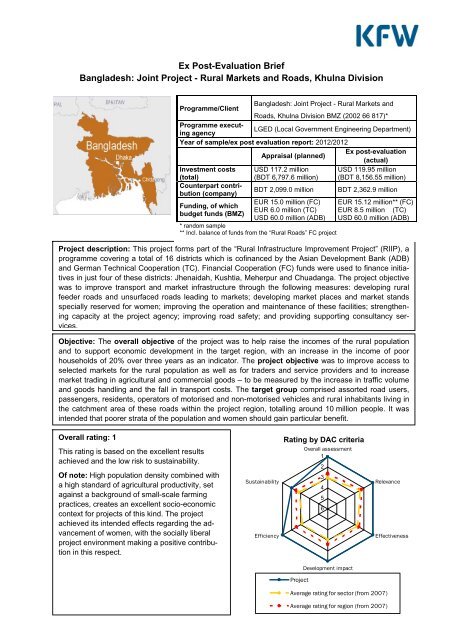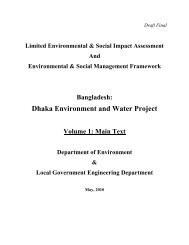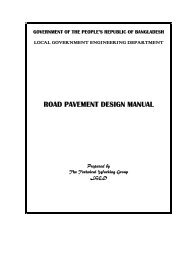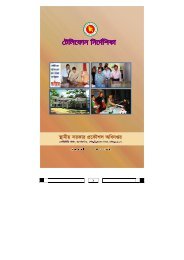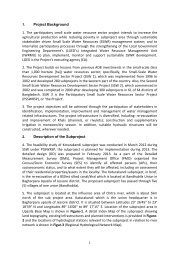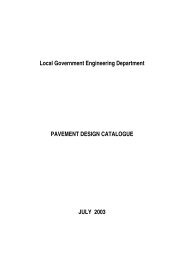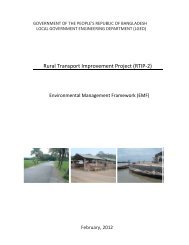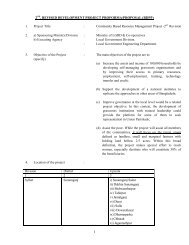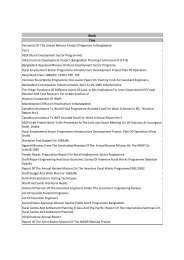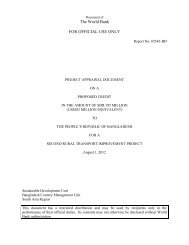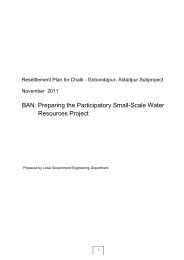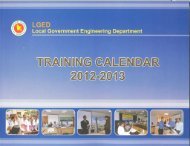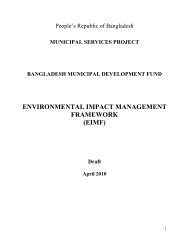Rural Markets and Roads, Khulna Division - LGED
Rural Markets and Roads, Khulna Division - LGED
Rural Markets and Roads, Khulna Division - LGED
Create successful ePaper yourself
Turn your PDF publications into a flip-book with our unique Google optimized e-Paper software.
Ex Post-Evaluation Brief<br />
Bangladesh: Joint Project - <strong>Rural</strong> <strong>Markets</strong> <strong>and</strong> <strong>Roads</strong>, <strong>Khulna</strong> <strong>Division</strong><br />
Programme/Client<br />
Bangladesh: Joint Project - <strong>Rural</strong> <strong>Markets</strong> <strong>and</strong><br />
<strong>Roads</strong>, <strong>Khulna</strong> <strong>Division</strong> BMZ (2002 66 817)*<br />
Programme executing<br />
agency<br />
<strong>LGED</strong> (Local Government Engineering Department)<br />
Year of sample/ex post evaluation report: 2012/2012<br />
Appraisal (planned)<br />
Ex post-evaluation<br />
(actual)<br />
Investment costs<br />
(total)<br />
USD 117.2 million<br />
(BDT 6,797.6 million)<br />
USD 119.95 million<br />
(BDT 8,156.55 million)<br />
Counterpart contribution<br />
(company)<br />
BDT 2,099.0 million BDT 2,362.9 million<br />
EUR 15.0 million (FC) EUR 15.12 million** (FC)<br />
Funding, of which<br />
EUR 6.0 million (TC) EUR 8.5 million (TC)<br />
budget funds (BMZ)<br />
USD 60.0 million (ADB) USD 60.0 million (ADB)<br />
* r<strong>and</strong>om sample<br />
** Incl. balance of funds from the “<strong>Rural</strong> <strong>Roads</strong>” FC project<br />
Project description: This project forms part of the “<strong>Rural</strong> Infrastructure Improvement Project” (RIIP), a<br />
programme covering a total of 16 districts which is cofinanced by the Asian Development Bank (ADB)<br />
<strong>and</strong> German Technical Cooperation (TC). Financial Cooperation (FC) funds were used to finance initiatives<br />
in just four of these districts: Jhenaidah, Kushtia, Meherpur <strong>and</strong> Chuadanga. The project objective<br />
was to improve transport <strong>and</strong> market infrastructure through the following measures: developing rural<br />
feeder roads <strong>and</strong> unsurfaced roads leading to markets; developing market places <strong>and</strong> market st<strong>and</strong>s<br />
specially reserved for women; improving the operation <strong>and</strong> maintenance of these facilities; strengthening<br />
capacity at the project agency; improving road safety; <strong>and</strong> providing supporting consultancy services.<br />
Objective: The overall objective of the project was to help raise the incomes of the rural population<br />
<strong>and</strong> to support economic development in the target region, with an increase in the income of poor<br />
households of 20% over three years as an indicator. The project objective was to improve access to<br />
selected markets for the rural population as well as for traders <strong>and</strong> service providers <strong>and</strong> to increase<br />
market trading in agricultural <strong>and</strong> commercial goods – to be measured by the increase in traffic volume<br />
<strong>and</strong> goods h<strong>and</strong>ling <strong>and</strong> the fall in transport costs. The target group comprised assorted road users,<br />
passengers, residents, operators of motorised <strong>and</strong> non-motorised vehicles <strong>and</strong> rural inhabitants living in<br />
the catchment area of these roads within the project region, totalling around 10 million people. It was<br />
intended that poorer strata of the population <strong>and</strong> women should gain particular benefit.<br />
Overall rating: 1<br />
This rating is based on the excellent results<br />
achieved <strong>and</strong> the low risk to sustainability.<br />
Of note: High population density combined with<br />
a high st<strong>and</strong>ard of agricultural productivity, set<br />
against a background of small-scale farming<br />
practices, creates an excellent socio-economic<br />
context for projects of this kind. The project<br />
achieved its intended effects regarding the advancement<br />
of women, with the socially liberal<br />
project environment making a positive contribution<br />
in this respect.<br />
Sustainability<br />
Efficiency<br />
Rating by DAC criteria<br />
Overall assessment<br />
1<br />
2<br />
3<br />
4<br />
5<br />
6<br />
Relevance<br />
Effectiveness<br />
Development impact<br />
Project<br />
Average rating for sector (from 2007)<br />
Average rating for region (from 2007)
EVALUATION SUMMARY<br />
Overall rating: Project design was appropriate. With the sole exception of maintenance, all<br />
the main objectives were either achieved or surpassed. Furthermore the project also contributed<br />
to institutional development (capacity building) at the project agency.<br />
If FC activities are to continue in this sector, the following design modifications should be<br />
pursued, in close cooperation with other major donors such as the ADB <strong>and</strong> the World<br />
Bank:<br />
- In operational terms, the model used - parallel financing, regional demarcation, <strong>and</strong> the<br />
individual inspection of hundreds of small projects - is expensive, <strong>and</strong>, in view of the<br />
strong institutional framework in place at <strong>LGED</strong> (the project agency), this is no longer<br />
necessary. Today <strong>LGED</strong> may well be in a position to manage a comparable project<br />
with a greater degree of responsibility; alternatively, targeted measures should be taken<br />
to increase capacity in particularly sensitive areas (procurement, project monitoring,<br />
<strong>and</strong> financial management).<br />
- Future projects should specifically consider climate protection issues, since Bangladesh<br />
is one of the countries most severely affected by climate change.<br />
- In the KfW-financed districts the project achieved its intended effects in the advancement<br />
of women, with the socially liberal project environment making a positive contribution<br />
in this regard. It should not be assumed that this format can be transferred to future<br />
projects in other regions; project design must depend instead on the specific socio-cultural<br />
framework, <strong>and</strong> here the social acceptance of women being economically<br />
active (<strong>and</strong>, most of all, economically independent) must receive particular attention.<br />
Rating: 1<br />
Relevance: At least half the Bangladeshi economy is based on agricultural production, with<br />
76% of the total population <strong>and</strong> 73% of the poor population living in rural areas. <strong>Rural</strong> development<br />
is therefore a government priority, based on key government strategy papers<br />
(cf. the Second National Strategy for Accelerated Poverty Reduction, 2009-11 (NSAPR II),<br />
<strong>and</strong> the Government of Bangladesh’s 6th Five-Year Plan 2010-15). The design of the project<br />
fits well with sector policies <strong>and</strong> strategies for rural areas. Recent studies by the World<br />
Bank (impact studies) confirm the impact on poverty <strong>and</strong> the advantages created by improved<br />
transport links to markets, social infrastructure <strong>and</strong> administrative centres. High<br />
population density combined with a high st<strong>and</strong>ard of agricultural productivity set against a<br />
background of small-scale farming practices offer an excellent socio-economic context for<br />
projects of this kind. Based on credible cause <strong>and</strong> effect relationships, the approach<br />
adopted targets improved living conditions for the disadvantaged rural population <strong>and</strong> thus<br />
makes a direct contribution to solving the core problem of poverty. It is worth noting that the<br />
approach adopted employed various measures - some at a local level, some at a sector<br />
level, <strong>and</strong> some directed toward the project agency - to target wide-ranging improvements<br />
in a number of locations (the sector, the project agency, user groups, <strong>and</strong> physical infrastructure),<br />
<strong>and</strong> that the intended effects were still in evidence even when sector improvements<br />
in road maintenance fell short of expectations.<br />
2
The project implementation organisations involved (KfW, GIZ, <strong>and</strong> ADB) – guided by the<br />
responsible party, the Local Government Engineering Department (<strong>LGED</strong>) – reached suitable<br />
agreements over the division of tasks, both in terms of content <strong>and</strong> regional responsibilities.<br />
By targeting improvements in rural infrastructure the project supports cooperation<br />
between Germany <strong>and</strong> Bangladesh within the priority area of good governance (Sub-<br />
Rating: 1).<br />
Effectiveness: The project objective was to improve access to selected markets for the<br />
rural population as well as for traders <strong>and</strong> service providers, <strong>and</strong> to increase market trading<br />
in agricultural <strong>and</strong> commercial goods. The following indicators were defined to measure<br />
progress toward the objective:<br />
Indicator<br />
Status at ex-post evaluation<br />
An increase in the income of poor households The income of poor households rose by 47%,<br />
(after three years of operation) of 20%.<br />
whereas income levels in a comparison group<br />
(where no measures were implemented) fell by<br />
11%, indicating a net effect of 58%.<br />
An increase in traffic on the rehabilitated roads Motorised traffic increased by 140% <strong>and</strong> nonmotorised<br />
traffic by 57%, whereas traffic in the<br />
of 30%.<br />
comparison region grew by only 78% (motorised<br />
traffic) <strong>and</strong> 28% (non-motorised), showing<br />
a weighted net effect of 37%.<br />
A fall in the cost of transport (for goods <strong>and</strong> Due to inflation <strong>and</strong> increased energy prices,<br />
passengers) of 10-15%.<br />
transport costs rose by 150% between 2004<br />
<strong>and</strong> 2011. However, compared to cost trends<br />
on roads used for comparison purposes, cost<br />
reductions of 65% were achieved for passengers,<br />
<strong>and</strong> 63% for goods.<br />
An increase in the volume of goods h<strong>and</strong>led by Market sales increased by 43%, whereas on<br />
the markets of 15%.<br />
comparison markets sales rose by 19%, giving<br />
a net effect of 24%.<br />
Each project component was implemented successfully <strong>and</strong> hence the project objective<br />
was achieved. All objective indicators save one - that the infrastructure should be free of<br />
defects, an aim which was not quantified in any greater detail - were either met or<br />
exceeded. Out of a total population of 23 million living in the region covered by the project,<br />
around 10 million people (2.37 million of them in the districts which received FC support)<br />
benefited directly or indirectly from the measures implemented.<br />
The staff of <strong>LGED</strong>, the project agency, received training in the areas of planning, budgeting,<br />
tendering <strong>and</strong> supervision. Instruction took the form of taught sessions <strong>and</strong> on-the-job<br />
training. The training proved successful (Sub-Rating: 1).<br />
3
Efficiency: There were minor delays when construction started, but the construction<br />
schedule was maintained (planned completion date at project appraisal: October 2009;<br />
actual completion: June 2009). Because of the savings that were achieved <strong>and</strong> favourable<br />
movements in the exchange rate, the outcome of the road development component, measured<br />
in physical terms, exceeded expectations (by approx. 21%). When compared to the<br />
specifications that were being followed, similar results were achieved in the development of<br />
the markets, the construction of buildings for local administrative authorities (Union Councils),<br />
the planting of roadside trees <strong>and</strong> the construction of bridges <strong>and</strong> culverts. An exception<br />
here were the buildings provided for the local administrative authorities (20, instead of<br />
25 as planned). This reduction happened at a very early stage (around the end of 2003),<br />
without the particular circumstances being documented in any further detail. The costs of<br />
the measures implemented stayed largely within the bounds of the original estimates. Local<br />
cost increases, especially in building materials, were more than offset by currency exchange<br />
gains <strong>and</strong> the efficiency of project implementation, which allowed the original scope<br />
of the project to be extended. Moreover, the labour-intensive nature of this programme’s<br />
project implementation activities had a substantial effect on employment (totalling approx.<br />
40,000 man years).<br />
Once project activities were completed, an overall economic cost-benefit analysis (EIRR)<br />
was carried out. This showed an overall economic rate of return of 38.1% – far higher than<br />
the level of 12% estimated at project appraisal. For rural development measures, these<br />
results are good to very good, <strong>and</strong> they far exceed original expectations. In view of the high<br />
rate of return, the extensive utilisation of the road transport infrastructure provided, <strong>and</strong> the<br />
substantial developmental impact on poorer strata of the population, the use of funds was<br />
both efficient <strong>and</strong> appropriate (Sub-Rating: 1).<br />
Overarching developmental impact: The overall objective for this project was defined as<br />
“to help raise the incomes of the rural population <strong>and</strong> to support economic development in<br />
the target region”. This objective was achieved. The relevant indicator (an increase of 20%<br />
in the incomes of poor households) was, at 58%, significantly exceeded. Furthermore, in<br />
terms of employment, the impact achieved was substantial. Over the lifetime of the project<br />
(20 years), 82,000 years of employment were created (40,000 during project implementation,<br />
of which FC accounted for 8,000; <strong>and</strong> 42,000 during infrastructure maintenance, of<br />
which FC accounted for 8,400). In addition, several hundred long-term posts were created<br />
for particularly disadvantaged women (the “hard-core poor”), tending the trees that were<br />
planted <strong>and</strong> the roadside verges. In all, around 2.37 million people are benefiting from project<br />
activities financed by FC (out of 10 million people who benefit from the overall project).<br />
The project’s direct developmental results also include the transition from non-motorised<br />
vehicles to motorised vehicles (a “modal shift”). This has enabled journey times to be reduced<br />
by 42%. It has also significantly improved access to social services 1 <strong>and</strong> markets,<br />
1 School enrolment increased by 28.4%; the number of weekly health visits per km of road made by<br />
nurses/ Union Health Workers in <strong>Khulna</strong> rose from 40 to 141.<br />
4
<strong>and</strong> has ensured they can be reached on a year-round basis. At the same time, this increase<br />
in traffic volume <strong>and</strong> density has not been accompanied by an increase in accident<br />
frequency rates. Official statistics for the <strong>Division</strong>s targeted by KfW state that road traffic<br />
accidents have fallen by approx. 13%. However, the actual numbers may well be higher, as<br />
only a small proportion of road accidents in Bangladesh are officially reported.<br />
The various measures included for the advancement of women were also developmentally<br />
significant. In this regard, the erection of special market st<strong>and</strong>s for women (“Women’s Market<br />
Corners”) <strong>and</strong> the participation of women in decision-making bodies (Union Councils<br />
<strong>and</strong> Market Mgt. Committees) enabled the greatest structural effects to be achieved: both<br />
these changes have become well established <strong>and</strong> now, in an otherwise male-dominated<br />
area, they meet with widespread acceptance. However, this success must also be seen<br />
against the liberal socio-cultural environment which prevails in the project region, where the<br />
participation of women in public <strong>and</strong> community life is more widely accepted <strong>and</strong> more in<br />
evidence than in other provinces. To that extent, this approach can only be transferred to<br />
other regions with appropriate modifications – <strong>and</strong>, in certain regions (or in certain circumstances),<br />
it cannot be transferred at all (Sub-Rating: 1).<br />
Sustainability: Project appraisal identified the risk posed by insufficient medium to longterm<br />
funding for road maintenance <strong>and</strong> saw that this, despite increasing budgetary allocations,<br />
would jeopardise the sustainability of the project. However, the “Road Fund” that was<br />
discussed at the time has yet to be put in place, although a legislative proposal in this area<br />
is currently under discussion. The same applies for the “Road Maintenance Policy”, which<br />
is presently being discussed within the Cabinet. This notes a funding shortfall of approx.<br />
BDT 20.98 billion (approx. EUR 200 million), with an <strong>LGED</strong> maintenance budget for<br />
2011/12 of approx. EUR 625 million (approx. EUR 60 million). Despite steady <strong>and</strong> substantial<br />
increases in the allocation of budget funds (approx. EUR 35 million being made available<br />
for this purpose at the start of the project), the funding shortfall - partly due to the<br />
marked expansion in the rural road network (from 20,693 km in 2002 to 82,573 km in 2012)<br />
- has continued to grow, <strong>and</strong> has now reached a size which threatens continuity. This situation<br />
is mitigated by the highly effective “Road <strong>and</strong> Structure Database Management System”,<br />
which enables funds to be allocated efficiently in accordance with clearly defined criteria.<br />
One of the selection criteria used refers to “donor-financed” roads, with these<br />
stretches demonstrating a comparatively good st<strong>and</strong>ard of maintenance. With one exception<br />
all the roads that were inspected are still in a good condition. This issue is very clearly<br />
understood by the project agency <strong>and</strong> is treated as a high priority. If the “<strong>Rural</strong> Road Maintenance<br />
Policy” is adopted as it st<strong>and</strong>s, the proposed financing mechanism could close the<br />
funding gap within seven years. We are therefore of the view that the prospects for the lasting,<br />
sustainable upkeep of the roads financed by this programme are, in principle, assured.<br />
With regard to the Growth Center <strong>Markets</strong> <strong>and</strong> the local administration buildings (Union<br />
Complexes), the sustainability of these infrastructure projects seems assured: for these<br />
facilities not only require less maintenance, they have also led to direct increases in local<br />
5
authority revenues which are sufficient to finance forthcoming maintenance work, all the<br />
more so as the “Market Management Committees” contribute to decisions on the use of<br />
funds. The markets <strong>and</strong> administrative buildings visited in the course of ex-post evaluation<br />
were in excellent condition. Moreover, since there is a direct correlation between the level<br />
of revenue <strong>and</strong> the condition of the Growth Center <strong>Markets</strong>, the sustainability of these<br />
measures may well be secure for the long term.<br />
Future projects should give specific consideration to climate protection issues, since Bangladesh<br />
is one of the countries most seriously affected by climate change, although this only<br />
applies to a limited extent of the region covered by this project (<strong>and</strong> the KfW districts of<br />
Jhenaidah, Kushtia, Meherpur <strong>and</strong> Chuadanga in particular) (Sub-Rating: 2).<br />
6
Notes on the methods used to evaluate project success (project rating)<br />
Projects (<strong>and</strong> programmes) are evaluated on a six-point scale, the criteria being relevance,<br />
effectiveness, efficiency <strong>and</strong> overarching developmental impact. The ratings are also used to arrive<br />
at a final assessment of a project’s overall developmental efficacy. The scale is as follows:<br />
1 Very good result that clearly exceeds expectations<br />
2 Good result, fully in line with expectations <strong>and</strong> without any significant<br />
shortcomings<br />
3 Satisfactory result – project falls short of expectations but the positive results<br />
dominate<br />
4 Unsatisfactory result – significantly below expectations, with negative results<br />
dominating despite discernible positive results<br />
5 Clearly inadequate result – despite some positive partial results, the negative<br />
results clearly dominate<br />
6 The project has no impact or the situation has actually deteriorated<br />
Ratings 1-3 denote a positive or successful assessment while ratings 4-6 denote a not positive or<br />
unsuccessful assessment<br />
Sustainability is evaluated according to the following four-point scale:<br />
Sustainability level 1 (very good sustainability) The developmental efficacy of the project (positive to<br />
date) is very likely to continue undiminished or even increase.<br />
Sustainability level 2 (good sustainability): The developmental efficacy of the project (positive to<br />
date) is very likely to decline only minimally but remain positive overall. (This is what can normally be<br />
expected).<br />
Sustainability level 3 (satisfactory sustainability): The developmental efficacy of the project (positive<br />
to date) is very likely to decline significantly but remain positive overall. This rating is also assigned if<br />
the sustainability of a project is considered inadequate up to the time of the ex post evaluation but is<br />
very likely to evolve positively so that the project will ultimately achieve positive developmental<br />
efficacy.<br />
Sustainability level 4 (inadequate sustainability): The developmental efficacy of the project is<br />
inadequate up to the time of the ex post evaluation <strong>and</strong> is very unlikely to improve. This rating is also<br />
assigned if the sustainability that has been positively evaluated to date is very likely to deteriorate<br />
severely <strong>and</strong> no longer meet the level 3 criteria.<br />
The overall rating on the six-point scale is compiled from a weighting of all five individual criteria as<br />
appropriate to the project in question. Ratings 1-3 of the overall rating denote a "successful" project<br />
while ratings 4-6 denote an "unsuccessful" project. It should be noted that a project can generally be<br />
considered developmentally “successful” only if the achievement of the project objective<br />
(“effectiveness”), the impact on the overall objective (“overarching developmental impact”) <strong>and</strong> the<br />
sustainability are rated at least “satisfactory” (rating 3).<br />
7


